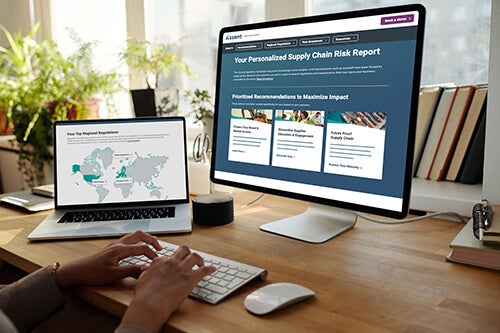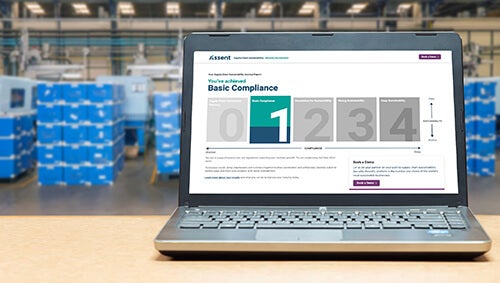Our regulatory subject matter experts help stakeholders solve unique regulatory challenges associated with supply chain data management. We compile their insights to help educate compliance professionals through content, webinars and events. Assent’s experts also provide advice directly to clients. Here are the top five questions our Regulatory team has responded to over the past month.
Question: A customer asked my company to mark our products as “lead free,” using either the “circle slashed Pb” emblem or an E2 marking. Our products comply with European Union (EU) Restriction of Hazardous Substances (RoHS) Directive, which involves strict limitations on lead. Does that mean we can mark our products “lead free”? If so, which symbol do we use?
Bruce Jarnot: It’s important to first understand what these marks, as a general lead-free designation, mean for your products.
The E2 (or e2) marking is a very specific designation of lead-free finish category under J-STD-609, a standard set by JEDEC (a developer of open standards for the microelectronics industry). It defines a tin alloy with no bismuth or zinc, with certain precisely-described exceptions and uses.
The only marking that should be used to designate a product’s conformity to the EU RoHS Directive is the CE marking. The EU prohibits the use of other potentially confusing marks or symbols for this purpose.
Question: My company makes products that are in scope of the EU RoHS Directive. Our products contain a battery pack, made up of a battery and battery cable. The battery and cable are supplied to us as a single unit. I know the batteries are not in scope of the EU RoHS Directive, but what about the attached cable?
Bruce Jarnot: Only the battery itself is out of scope. The cable, as well as any connectors, solder, etc., all remain in scope of the EU RoHS Directive.
Question: Where can I find information about the laws EU member states have made to enforce the EU Waste Framework Directive?
Raj Takhar: The EU Waste Framework Directive (WFD) sets a July 2020 deadline for EU member states to transpose the directive’s requirements into their national legal frameworks. This process allows the EU WFD’s requirements to be legally enforced.
The official list of EU members’ legal transpositions is available here, along with more detailed information and links for referenced legislation. It’s common for member states to wait until the last minute to meet transposition timelines, meaning it will likely be the summer before more clear information is available.
With the COVID-19 pandemic, it is possible that some flexibility in this deadline may be granted due to the impact on member states’ governmental operations. Refer to the European Chemicals Agency (ECHA)’s EU WFD page for the latest information.
Question: My company has focused our Registration, Evaluation, Authorisation and Restriction of Chemicals (REACH) Regulation due diligence efforts on substances of very high concern (SVHCs). Substances of very high concern are the aspect of the REACH Regulation we hear most about. Should we also be concerned about REACH Annex XIV and XVII? These seem to be treated as different issues, and our Assent module for SVHCs doesn’t address them.
James Calder: Requirements for REACH SVHCs, Authorised substances (Annex XIV) and Restrictions (Annex XVII) involve different substances, a different scope and different objectives. Assent offers modules covering each of these, since the differences mean companies may determine that not all aspects present a risk to their business.
The business risk associated with Annex XIV is largely associated with production operations in the EU that use SVHCs (as cleaners, coatings, etc.)
Annex XVII involves substance restrictions for very specific purposes. The greatest impact tends to be in business sectors involved with the substances or mixtures themselves, or with finished goods used in high volumes in the consumer industry.
Question: How should manufacturers handle a situation where a newly-sourced material must be released to keep production running, but no conformance declaration has yet been received for the REACH Regulation, EU RoHS Directive or other applicable legislation?
Valerie Kuntz: Generally speaking, European regulators require evidence of an ongoing due diligence program for the REACH Regulation and EU RoHS Directive. If you can be certain your compliance process will collect data from any new supplier and lead to any necessary compliance actions, such as communication under the REACH Regulation, you are likely to remain in good standing.
However, complications may arise if the requested documentation is not made available, or if it contains unexpected information. A more conservative approach is to prevent changes to production, or to allow only limited manufacturing of a new or altered product, until all necessary information is available. If compliance documentation is ultimately not provided, a risk assessment may help companies decide what to do next. Factors to consider include the material/part risks, supplier risk, company risk tolerance, etc.
Whenever possible, compliance review and documentation should be completed before this type of change is made. Companies are in a better position to request documentation from the supplier before the new material is purchased and in use.
For more questions and answers, visit the last edition of Assent’s Ask the Experts blog.
Assent’s regulatory subject matter experts provide invaluable insight and guidance. Learn more about how they can help your company by contacting us to book a live demo.







